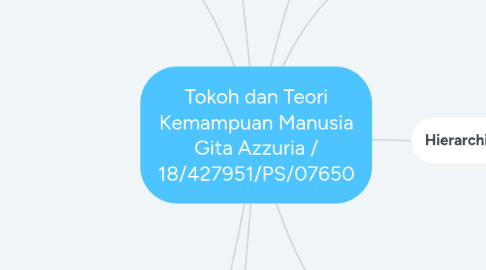
1. "Kenapa ada orang dengan IQ yang sama tapi prestasi kerja mereka berbeda?
2. Two-Factor Theory
2.1. Charles Spearman
2.1.1. Faktor g (general)
2.1.1.1. Skills of
2.1.1.1.1. memahami hubungan
2.1.1.1.2. memanipulasi hubungan
2.1.1.1.3. u/ mengatasi masalah
2.1.2. Faktor s (spesifik)
2.1.2.1. Skills of
2.1.2.1.1. memahami hubungan
2.1.2.1.2. memanipulasi hubungan
2.1.2.1.3. u/ konteks tertentu aja
3. Hierarchial Theory
3.1. Philip E. Vernon
3.1.1. mix of Spearman and Thurstone theory
3.1.1.1. Skills of
3.1.1.1.1. I. General (g)
3.1.1.1.2. II. Group mayor
3.1.1.1.3. III. Group minor
4. Primary Mental Ability
4.1. Louis Thurstone
4.1.1. no G factors
4.1.2. Skills of
4.1.2.1. verbal comprehension
4.1.2.2. associative memory
4.1.2.3. perceptual speed
4.1.2.4. inductive reasoning
4.1.2.5. word fluency
4.1.2.6. number
4.1.2.7. space
5. CHC Theory
5.1. Penemu: Cattell Penyempurna: Horn, Carroll
5.1.1. Skills of
5.1.1.1. Stratum III: general intelligence (g)
5.1.1.2. Stratum II: broad ability factors
5.1.1.2.1. Fluid- intelligence/reasoning (Gf)
5.1.1.2.2. Crystallized intelligence/knowledge (Gc
5.1.1.2.3. Domain-specific knowledge (Gkn)
5.1.1.2.4. Visual-spatial abilities (Gv)
5.1.1.2.5. Auditory processing (Ga)
5.1.1.2.6. Broad retrieval (memory) (Gr)
5.1.1.2.7. Cognitive processing speed (Gs
5.1.1.2.8. Decision/reaction time/speed (Gt)
5.1.1.3. Stratum I: narrow abilities
6. Structure of Intellect Model
6.1. Guilford
6.1.1. Dimensions of intellectual ability
6.1.1.1. Operation
6.1.1.1.1. cognition
6.1.1.1.2. memory (recording & retention)
6.1.1.1.3. convergent production
6.1.1.1.4. divergent production
6.1.1.2. Content
6.1.1.2.1. figural
6.1.1.2.2. symbolic
6.1.1.2.3. semantic
6.1.1.2.4. behavior
6.1.1.3. Product
6.1.1.3.1. unit
6.1.1.3.2. class
6.1.1.3.3. relation
6.1.1.3.4. system
6.1.1.3.5. transformation
6.1.1.3.6. implication
7. Theory of Multiple Intelligence
7.1. Howard Gardner
7.1.1. Aspects of intelligence
7.1.1.1. componential (analytical) intelligence
7.1.1.1.1. metacomponent/executive process
7.1.1.1.2. performance components
7.1.1.1.3. knowledge-acquisition components
7.1.1.2. experiential (creative) intelligence
7.1.1.2.1. ability to
7.1.1.3. contextual (practical) intelligence
7.1.1.3.1. adaptation
7.1.1.3.2. selection of suitable environment
7.1.1.3.3. shaping of environment
7.1.2. intinya: kemampuan adaptasi
7.1.3. inclusion criteria
7.1.3.1. linguistic
7.1.3.2. logical-mathematical
7.1.3.3. spatial
7.1.3.4. musical
7.1.3.5. bodily-kinesthetic
7.1.3.6. interpersonal
7.1.3.7. intrapersonal
7.1.3.8. naturalistic
7.1.3.9. existential
7.1.3.10. spiritual
8. The Triarchic Theory
8.1. Stenberg
8.1.1. Skills of
8.1.1.1. analytical intelligence
8.1.1.1.1. mental steps ->solve problem
8.1.1.2. creative intelligence
8.1.1.2.1. experience -> faster insight
8.1.1.3. practical intelligence
8.1.1.3.1. read and adapt to everyday lif
